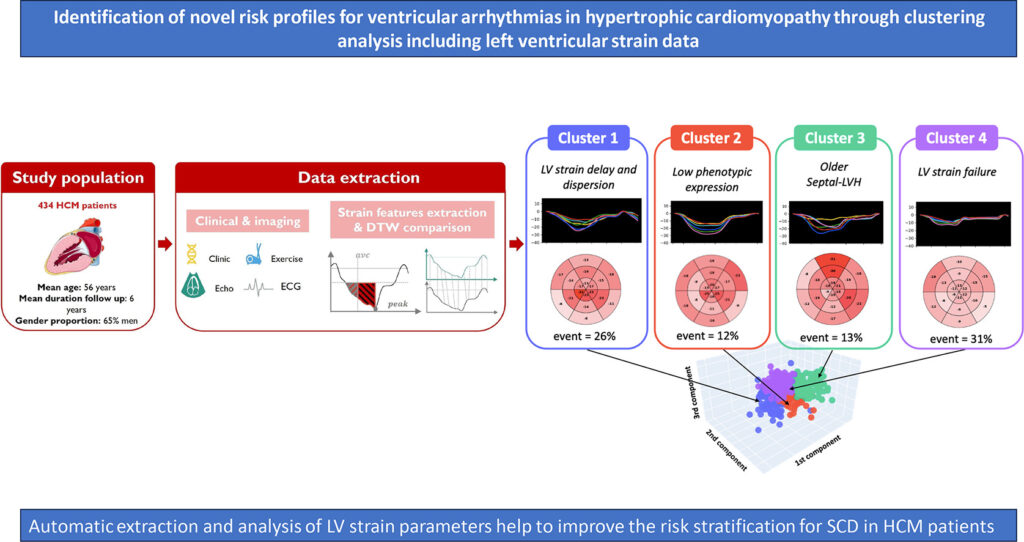A recent study published in the International Journal of Cardiology highlights innovative findings on ventricular arrhythmias (VA) risk profiles in hypertrophic cardiomyopathy (HCM). The study, led by a research team at University of Rennes, a SMASH-HCM project beneficiary, in collaboration with the University of Oslo, utilised advanced clustering analysis to improve risk stratification for VA in HCM patients.
Hypertrophic cardiomyopathy (HCM) is a complex and prevalent genetic heart disease that affects the heart’s ability to pump blood effectively due to thickened heart walls. While most patients can live with the condition, some face a heightened risk of life-threatening ventricular arrhythmias (VA), leading to sudden cardiac death, especially in younger individuals. Accurate prediction of which patients are most at risk remains a significant challenge in clinical care.
Clustering Analysis Offers New Insights
The study analysed a cohort of 434 HCM patients across two referral centres (Rennes, France and Oslo, Norway) using a combination of clinical and imaging data, including left ventricular longitudinal strain (LV-LS) parameters. This advanced analysis allowed the team to extract a total of 287 features per patient and apply a clustering approach to identify subgroups with varying levels of ventricular arrhythmias (VA) risk.
The research identified four distinct clusters of patients, with clusters 1 and 4 being at significantly higher risk for ventricular arrhythmias (VA rates of 26% and 31%, respectively). Patients in cluster 1 were distinguished by a marked deformation delay in the left ventricular myocardium, reflecting increased mechanical dispersion. This irregularity in heart muscle contraction timing is a well-established indicator of elevated arrhythmic potential.
In contrast, cluster 4 represented patients with more severe myocardial remodelling, characterised by thickened heart walls and reduced heart function. These patients exhibited the most severe phenotypes of HCM, including significant left ventricular mass and impaired exercise capacity, both of which are associated with a higher risk of arrhythmias and adverse cardiovascular outcomes.
Impact on Risk Stratification and Personalised Treatment
By using a combination of conventional clinical markers and LV strain data, this clustering method has increased the ability to predict which patients are at the greatest risk of ventricular arrhythmias. Current methods for stratifying VA risk, such as the European Society of Cardiology’s risk score, rely on a limited number of variables. In contrast, this machine learning-driven approach processes a far greater range of clinical and imaging data, leading to more refined, patient-specific risk profiles.
The ability to stratify patients based on their unique ventricular strain patterns and clinical characteristics is a significant advance. These findings open the way for improved decision-making in the management of HCM, allowing clinicians to better identify high-risk patients who may require interventions such as implantable defibrillators or more intensive medical management.
Enhancing the Goals of the SMASH-HCM Project
The insights gained from this study are highly relevant to the mission of the SMASH-HCM project, which is focused on developing a digital-twin platform that integrates advanced biophysical and data-driven models to improve the stratification and management of HCM. The clustering analysis presented in this study highlights how advanced imaging and machine learning techniques can lead to more personalised and precise treatment strategies for HCM patients, aligning closely with the goals of SMASH-HCM.
This study represents an important step in using advanced data analysis to tackle one of the most challenging aspects of HCM care – predicting the risk of life-threatening arrhythmias. By identifying specific subgroups of patients with higher rhythmic risk, clinicians can make more informed decisions, ultimately improving outcomes for individuals living with this complex condition.
For more information, read the full study published in the International Journal of Cardiology here.
